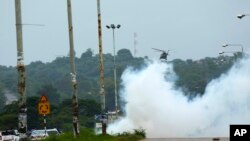Tonderai Gonorenda
HARARE (Reuters) - Before prices of basic goods spiked in Zimbabwe this month, cab driver and father-of-six Victor Makazhu could buy nearly two weeks of groceries for $45. Now that sum will get him less than seven days’ worth.
Inflation soared to a 10-year high above 40 percent in December and has probably risen further since President Emmerson Mnangagwa last week raised fuel prices by 150 percent, leading to protests that have triggered a crackdown by security forces.
“At the moment I cannot afford adequate food for my family,” Makazhu said after shopping for staples in central Harare on Thursday.
“These groceries will not last me a week,” he told Reuters, pointing to 2 kg packs of sugar, rice, flour and maize meal and milk.
The southern African nation dumped its hyperinflation-wrecked currency in 2009 and adopted the dollar.
Over time, supplies of dollars have dried up and, in November 2016, authorities in Harare launched a surrogate - ‘bond notes’ covered by a hard currency loan and pegged at 1:1 to the dollar.
On the street, however, $1 now fetches up to three bond notes, leaving citizens able to do little but watch as the money in their bank accounts loses value compared with hard cash.
Few could blame Zimbabweans for feeling a sense of deja vu.
While nowhere near the 500 billion percent hyperinflation of the crisis of 2008, the country is again grappling with soaring prices and shortages of fuel and medicines.
After four hours of what locals call ‘speculative queueing’ outside a filling station in the centre of town, schoolteacher Gilbert Kepekepe was still nowhere near getting served.
Before the latest price increase he used to spend $230 to fill his tank, which he did twice a month. Now that would cost him $528.
“I will have to probably cut on some other things or simply decide not to drive to work. But the other question is, ‘is it cheaper to use public transport’,” said Kepekepe
Analysts said the fuel price hike would trickle down to other basic goods and services, and public taxis known as “kombis” have at least doubled their fares in the last two weeks.
Writing by MacDonald Dzirutwe; editing by John Stonestreet




